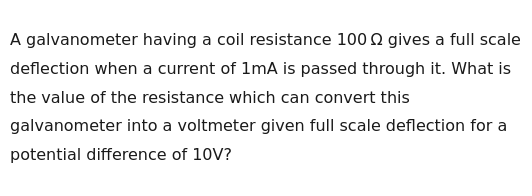Question
Question: A galvanometer having a coil resistance 100 Ω gives a full scale deflection when a current of 1mA is...
A galvanometer having a coil resistance 100 Ω gives a full scale deflection when a current of 1mA is passed through it. What is the value of the resistance which can convert this galvanometer into a voltmeter given full scale deflection for a potential difference of 10V?

9900 Ω
Solution
To convert a galvanometer into a voltmeter, a high resistance (R) is connected in series with the galvanometer.
Given data:
- Coil resistance of the galvanometer, G=100Ω
- Full scale deflection current of the galvanometer, Ig=1mA=1×10−3A
- Desired full scale deflection voltage for the voltmeter, V=10V
Formula: When a resistance R is connected in series with the galvanometer, the total resistance of the voltmeter circuit is Rtotal=G+R. For full scale deflection, the voltage across the voltmeter is given by Ohm's law: V=Ig×(G+R)
Rearranging the formula to solve for R: G+R=IgV R=IgV−G
Calculation: Substitute the given values into the formula: R=1×10−3A10V−100Ω R=0.00110−100 R=10000−100 R=9900Ω
Therefore, a resistance of 9900 Ω must be connected in series with the galvanometer to convert it into a voltmeter with a 10V range.
